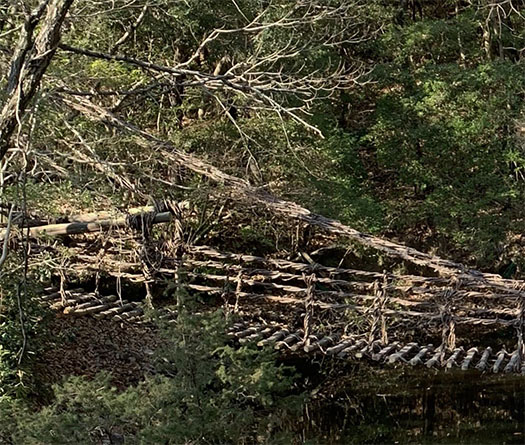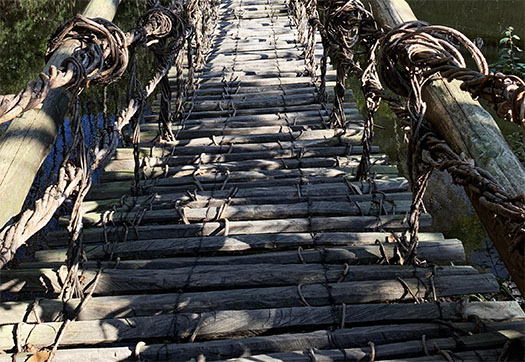


きのうの続篇ですが、平家の落人たちが集団で四国の「秘境」に退隠したという
落人伝承はほかの事例を考えてもたぶん事実だろうと思います。
このブログでも以前、能登半島の「時国家住宅」上下両家を取材していて
鄙にあっても「大納言様式」という格式を維持し続けた具体的事例をみた。
始祖を平時忠(平清盛義弟で大納言)とする800年続く旧家。
現代に至っても田中角栄のロッキード事件の裁判長を末裔の時国家は輩出した。
もちろん一族すべてが繁栄し続けることはムリがあっただろうから
そのなかの一家でも残そうという意思があったのだと思う。
ただ、時国家住宅の場合は能登という海上交通の要衝であったことで、
存続し続ける経済的根拠があったと思えるのですね。
時国家の事例は平家落人伝説の残る日本各地の中でやはり特異なのでしょう。
能登という海上交通的には利便性のある地域だけれど陸上交通的には
越前から富山のルートからは隔絶して結果幕府との妥協が成立したのだろうし、
また、江戸期になっては活発な北前交易という事業機会を生かすこともできた。
しかし、こちら祖谷の屋島合戦敗残勢力の場合、
とにかく一族の安全最優先でとんでもない山奥に隠れ住んだ。
源平合戦は高松市近郊の屋島での戦いがたぶんクライマックスであって
壇ノ浦時点では平家に勝利の目算、京都への復帰戦略も失っていたに違いない。
屋島はそれだけの重心を込めた拠点だったのだと思える。
その拠点が失われたことで事実上平家は滅亡し残存勢力は散り散りになった。
地理的に考えるとこの秘境に逃げ込む心理は追い詰められた究極の選択かと。
時国家の場合にはその後の生き延び方策を練った上での立地戦略性があるが、
この祖谷退却には戦略性は見通しにくく当面の危機回避だけだったのではないか。
この点、時国家の始祖の経済人・平時忠と祖谷の始祖の武人・平教経(国盛)の
戦略眼の違いを感じさせられる。退却戦でも戦い方はあるのだと思う。
平氏軍団には当然、陣地の構築とか移動の兵站作戦家もいただろう。
軍隊移動はそれこそ軍事の要諦。神出鬼没な作戦計画が合戦の雌雄を決した。
このかずら利用の架け橋技術はそういった軍事のプロが係わっていた痕跡が強い。
通常では考えられないような部隊移動を可能にすることは
敵の作戦計画を凌駕することに直接繋がる軍事の最大眼目。
やはりこの山奥での架橋にはそういう技術痕跡を感じさせられる。
源氏の討手が祖谷の地に迫ってきたとき、敵の侵入を防ぐために、
いつでも切り落とせるように蔓を束ねて橋を造ったのが「かずら橋」といわれる。
両岸側の起点の木組み、かずらの編み上げ手法、そして踏み木材の保持方法など
それぞれにいかにも軍事起源のテックを感じる。
とくに足下の簡略性などはいかにも武人たちに合わせた機能性の絞り方と思える。
普通人、女人などを基準に考えればもうちょっと安全優先になるのではないか。
悲鳴を上げる怖い体験は身体能力を活性化させるのだという。
体技能力が生死をわける武人たちにとってこういう架橋は鍛錬にもなっていたか。
English version⬇
[Mountain bridge construction technology using Kazura Shikoku living space exploration-3]
It is a sequel to yesterday, but it is said that the Heike deceased people collectively retired to the “unexplored region” of Shikoku.
I think that the folklore is probably true even if you consider other cases.
In this blog as well, I used to cover both the upper and lower houses of “Tokikuni Housing” on the Noto Peninsula.
I saw a concrete example of maintaining the form of “Dainagon style” even in the countryside.
An old family that has been around for 800 years and whose founder is Taira no Tokitada (Taira no Kiyomori’s brother-in-law and Dainagon).
Even in modern times, the nation produced the presiding judge of the Lockheed scandal of Kakuei Tanaka when he was a descendant.
Of course, it would have been unreasonable for the whole clan to continue to prosper.
I think there was an intention to leave even one of them.
However, in the case of Tokikuni Housing, it was a key point of maritime transportation called Noto.
It seems that there was an economic basis for survival.
The case of Tokikuni is probably peculiar in various parts of Japan where the legend of Heike Ochijin remains.
Noto is a convenient area for maritime transportation, but it is convenient for land transportation.
It seems that a compromise with the Shogunate was reached as a result of being isolated from the route from Echizen to Toyama.
Also, in the Edo period, we were able to take advantage of the business opportunity of active Kitamae trade.
However, in the case of the remnants of the Yashima battle in Iya,
Anyway, the safety of the clan was the highest priority, and I lived in a ridiculous mountain.
The Genpei War was probably the climax of the battle at Yashima near Takamatsu City.
At the time of Dannoura, he must have lost the prospect of victory and the strategy of returning to Kyoto.
It seems that Yashima was a base with that much center of gravity.
The loss of that base effectively destroyed the Heike and scattered the remaining forces.
Geographically, the psychology of escaping into this unexplored region is the ultimate choice.
In the case of Kami Tokikuni, there is a location strategy after devising a survival plan after that,
It seems that the strategic nature of this retreat from Iya was difficult to see, and it was only the immediate crisis avoidance.
In this regard, Taira no Tokitada, the founder of Tokikuni, and Taira no Noritsune, the founder of Iya,
You can feel the difference in strategic eyes. I think there is a way to fight even in the retreat battle.
Of course, the Taira clan corps would also have logistical operators to build positions or move.
Army movement is the essence of the military. The devilish strategy plan decided the sex of the battle.
There is a strong trace that such military professionals were involved in this bridge technology using Kazura.
To enable troop movements that would not normally be possible
The greatest military eye that directly leads to surpassing the enemy’s operational plans.
After all, the bridge in the mountains makes us feel such a trace of technology.
When Genji’s debater approaches the land of Iya, in order to prevent the invasion of the enemy,
It is called “Kazura Bridge” that the bridge was built by bundling vines so that it could be cut off at any time.
The starting point of the timber on both banks, the method of knitting chasuble, and the method of holding the tread wood, etc.
I really feel the tech of military origin in each.
In particular, the simplicity of the feet seems to be a way to narrow down the functionality to suit the warriors.
Considering the criteria of ordinary people and women, it may be a little more safety priority.
The scary experience of screaming activates physical fitness.
Was this kind of bridge a discipline for the warriors whose physical skills are the difference between life and death?
Posted on 2月 11th, 2022 by 三木 奎吾
Filed under: 住宅マーケティング, 歴史探訪







コメントを投稿
「※誹謗中傷や、悪意のある書き込み、営利目的などのコメントを防ぐために、投稿された全てのコメントは一時的に保留されますのでご了承ください。」
You must be logged in to post a comment.